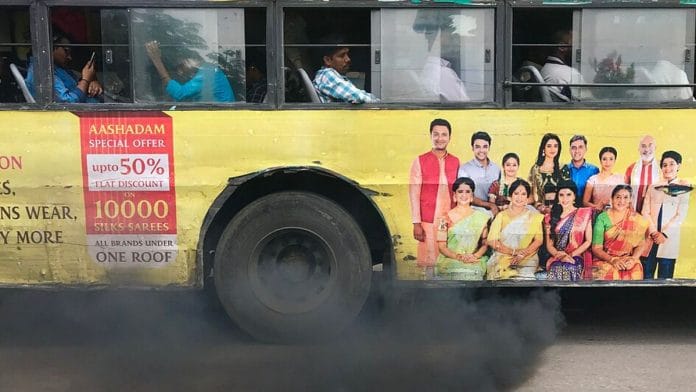Bengaluru: Heavy commercial vehicles such as buses and trucks are responsible for 70 percent of vehicular pollution in India, even though they form just around two percent of the country’s vehicles, according to a study by the Center for Study of Science, Technology and Policy (CSTEP).
A new report by the think tank, released at the India Clean Air Summit (ICAS) 2025 in Bengaluru, found that though the number of heavy commercial vehicles is expected to rise by 27 percent by 2035, emission levels will decrease as India adopts Bharat Stage VI (BS-VI) guidelines.
The report also found “super emitters”, or older vehicles that release more pollutants than average, will “continue to dominate fleet emissions”, undermining efforts to control vehicular pollution levels.
“We have left a section of the vehicular fleet that is most polluting and our focus is shifted to passenger vehicles. And that’s what this report tries to highlight,” Swagata Dey, lead author of the report and policy specialist at CSTEP, told The Print.
“Our vehicular pollution isn’t coming down if these super emitters continue. No matter how many new EVs you bring in, the older ones are still polluting,” Dey added.
The report criticised current policies, including the Voluntary Vehicle Fleet Modernisation Programme (VVMP), for lacking practical measures to control emissions by super-emitters.
“A phased, pragmatic approach, prioritising super-emitters and transitioning to cleaner fuels, can drive significant air quality benefits and support India’s clean transport goals,” the report said.
Scrap now
Dey said electric trucks are not the answer because of the lack of highway charging infrastructure. Instead, compulsory scrapping of old trucks was needed.
“You have to scrap old trucks. Right now, scrappage is voluntary. Most scrappage facilities we spoke to said that while they are equipped to handle heavy vehicles, most of (what they receive) is just passenger cars,” Dey added.
The report found that 40 percent of trucks on the road are more than 15 years old.
According to Dey, trucks are not retired like private cars. “They run till they break down. They are abused and there is no maintenance,” she said. “If you wait for electrification of heavy vehicles, you will have to wait for 10 years, and the problem would have compounded even more.”
Dey suggested government subsidies for smaller truck owners with two or three trucks who fear that mandatory scrapping will deprive them of their livelihood.
The registration riddle
The report also highlighted that tracking state-wise truck emissions does not give a full picture. For example, Nagaland has a lot of truck registrations due to taxation reasons, but its trucks move all over India.
“That’s why the ground surveys are also important because if you just rely on theoretical data, then you will see that emissions are only from one small state in India, Nagaland,” Dey explained.
To address this, the survey team developed a bottom-up emission inventory using 15 years of Ministry of Road Transport and Highways (MoRTH) registration data for heavy commercial vehicles and emission factors for different vehicle classes.
To validate the findings, the team conducted ground-level surveys that confirmed the presence of super emitters on the road. “Another problem with the trucking ecosystem is that state-wise interventions will not work. It has to come from the national level, as all trucks have interstate national permits,” Dey added.
Most trucks run on diesel and India’s dependence on diesel is unlikely to end soon.
India’s diesel dependence will persist at least until 2035, according to a report published in June 2025 by the Council on Energy, Environment and Water, a policy think tank.
“There is diesel dominance right now as most trucks are running on diesel. The jump we are talking about is diesel to electric, which is too big. Interim solutions like CNG, railways are important,” Dey said.
Even though the Indian railway transportation is electrified, according to Dey, freight has shifted from rail to road in the last 10 years. “So, the modal shift of freight movement has to go back to rail,” she said.
Dey suggests that in the case of ports, if building a railway station is not feasible, a better option is to only rely on trucks for last mile connectivity from railway station to the ports. For instance, if the goods move from Uttar Pradesh to Kerala are entirely done through road, the freight could be moved by rail from UP to the nearest major railway station in Kerala and then for the last mile connectivity seek help from the trucks, according to Dey. “That way, 80 percent of it goes to rail. 20 percent remains on road freight,” Dey added.
(Edited by Sugita Katyal)







All money for socialism, no money to buy new buses. Vote for Kejriwala and receive free Las Vegas yatra. Jai Kejrwala, Jai comrade Brinjal Karrot.